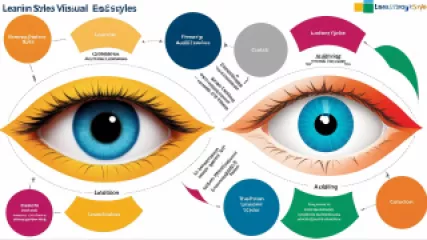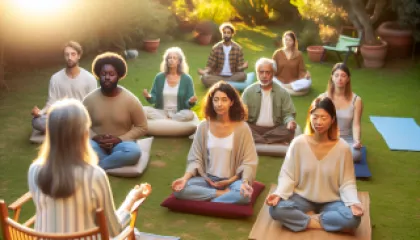Discover Your Learning Style: A Step-by-Step Guide to Boosting Emotional Intelligence
Discover Your Learning Style: A Step-by-Step Guide to Boosting Emotional Intelligence
In today's fast-paced world, where information is abundant and our daily lives are filled with a constant barrage of stimuli, it's more important than ever to understand how we learn best. By tapping into our unique learning preferences, we can not only absorb and retain information more effectively, but also cultivate the emotional intelligence necessary to navigate the complexities of life with greater ease and success.
In this comprehensive guide, we'll embark on a journey of self-discovery, exploring the different learning styles and how they can be harnessed to unlock your full potential. Whether you're a visual learner, an auditory enthusiast, or a kinesthetic explorer, this step-by-step approach will equip you with the tools and strategies to optimize your learning experiences and foster the growth of your emotional intelligence.
Understanding the Basics of Learning Styles
Learning styles refer to the preferred methods by which individuals process and retain information. While everyone has the capacity to learn in multiple ways, most people tend to gravitate towards one or two dominant learning modalities. The three primary learning styles are:
- Visual Learning: Individuals who thrive in this style learn best through the use of images, diagrams, charts, and other visual aids. They often have a strong aptitude for visualizing concepts and tend to remember information that they have seen.
- Auditory Learning: These learners excel at processing and retaining information through sound, including lectures, discussions, and audio recordings. They may find it easier to remember spoken instructions or to learn through podcasts and audiobooks.
- Kinesthetic Learning: Kinesthetic learners are hands-on individuals who prefer to learn through physical movement and tactile experiences. They often benefit from interactive activities, role-playing, and the opportunity to physically engage with the subject matter.
Understanding your dominant learning style can be a game-changer in your personal and professional development, as it allows you to tailor your learning experiences to your strengths and preferences.
Assessing Your Learning Style
The first step in harnessing the power of your learning style is to identify it. There are various online assessments and questionnaires available that can help you determine your primary learning modality. One such tool is the VARK Questionnaire (Visual, Auditory, Read/Write, Kinesthetic), which provides a comprehensive analysis of your learning preferences.
As you complete the assessment, pay attention to the questions that resonate the most with you. Do you find yourself drawn to visual aids, or do you prefer to learn through hands-on experiences? Do you excel at remembering information you've heard, or do you thrive when you can take notes and review written materials?
Once you've identified your dominant learning style, take some time to reflect on how it aligns with your past learning experiences and the ways in which you've been successful in the past. This self-awareness will be crucial as you begin to incorporate learning style strategies into your daily life.
Optimizing Your Learning Experience
With your learning style in mind, it's time to start tailoring your approach to learning and personal growth. Here are some strategies to help you make the most of your preferred modality:
Visual Learners
As a visual learner, you'll thrive in environments that incorporate a wealth of visual aids, such as:
- Colorful, well-organized note-taking with diagrams, mind maps, and charts
- Watching informative videos, TED Talks, or webinars to supplement your learning
- Creating visual representations of concepts, such as flowcharts or infographics
- Utilizing online tools and apps that allow you to create and interact with visual content
By engaging your natural inclination towards the visual, you'll find that information sticks better, and you're able to recall and apply what you've learned with greater ease.
Auditory Learners
For auditory learners, the key is to incorporate more listening-based activities into your learning routine:
- Actively participate in discussions, seminars, or group conversations to cement your understanding
- Listen to audio recordings, podcasts, or audiobooks to supplement your learning
- Engage in role-playing or verbal rehearsal to solidify your knowledge
- Leverage voice-to-text or voice memo apps to capture your thoughts and ideas
By immersing yourself in auditory experiences, you'll find that you're able to internalize and recall information more effectively, ultimately enhancing your emotional intelligence and problem-solving abilities.
Kinesthetic Learners
For kinesthetic learners, the focus should be on incorporating hands-on, experiential learning opportunities:
- Engage in interactive workshops, simulations, or lab-based activities to apply your knowledge
- Use fidget toys or other tactile items to help you focus and absorb information
- Take regular breaks to move around, stretch, or engage in physical activities that complement your learning
- Collaborate with others through group projects or team-building exercises
By allowing your body to actively participate in the learning process, you'll find that you're able to better comprehend, retain, and apply the information you're acquiring.
Cultivating Emotional Intelligence
As you optimize your learning experiences to align with your preferred modality, you'll find that the benefits extend far beyond the acquisition of knowledge. By tapping into your unique learning style, you'll also be cultivating the emotional intelligence necessary to navigate the complexities of life with greater self-awareness, empathy, and resilience.
Emotional intelligence, or EQ, is the ability to recognize, understand, manage, and reason with emotions. It's a critical component of personal and professional success, as it allows us to build stronger relationships, make more informed decisions, and effectively cope with the challenges we face.
By understanding your learning preferences, you'll be better equipped to:
- Develop self-awareness: Identifying your learning style can help you gain a deeper understanding of your strengths, weaknesses, and preferred modes of processing information. This self-awareness is the foundation of emotional intelligence, as it allows you to make more informed choices and adapt your approach to different situations.
- Enhance empathy and social skills: As you become more attuned to your own learning needs, you'll also be better equipped to understand and accommodate the preferences of others. This increased empathy can lead to stronger interpersonal relationships and more effective communication.
- Cultivate resilience and adaptability: By recognizing your learning style and developing personalized strategies for growth, you'll be better equipped to navigate challenges and setbacks. This resilience, combined with the ability to adapt to changing circumstances, are hallmarks of emotional intelligence.
In essence, by aligning your learning experiences with your unique preferences, you'll not only become a more effective learner but also unlock the potential for greater emotional intelligence – a powerful combination that can propel you towards personal and professional success.
Integrating Learning Styles into Your Daily Life
Integrating your learning style into your daily life is a journey of self-discovery and continuous improvement. Here are some tips to help you seamlessly incorporate your preferred modality into your routine:
Create a Learning-Conducive Environment
Tailor your workspace, study area, or learning environment to cater to your learning style. For visual learners, this might mean adorning the space with inspirational imagery, color-coded notes, and visual aids. Auditory learners may benefit from a quieter setting with access to audio resources, while kinesthetic learners might thrive in a more open, movement-friendly area.
Leverage Technology and Online Resources
Utilize technology and online tools to enhance your learning experience. Visual learners can explore interactive e-learning platforms, virtual whiteboards, and video tutorials. Auditory learners can immerse themselves in podcasts, audiobooks, and webinars. Kinesthetic learners can engage with simulations, virtual labs, and hands-on digital activities.
Experiment with Different Learning Strategies
Don't be afraid to try new techniques and approaches to learning. While your dominant learning style should serve as a guiding principle, incorporating complementary strategies can help you develop a more well-rounded and adaptable skill set. For example, a visual learner might experiment with audio recordings or physical models to supplement their learning.
Seek Out Opportunities for Practical Application
Whenever possible, look for opportunities to apply your newly acquired knowledge and skills in practical, real-world settings. This not only reinforces your understanding but also allows you to develop the emotional intelligence necessary to navigate complex situations. Kinesthetic learners may thrive in internships or hands-on projects, while visual and auditory learners can benefit from presenting their ideas or engaging in interactive workshops.
Foster a Growth Mindset
Embrace a growth mindset – the belief that your abilities can be developed through dedication and hard work. This mindset, combined with an understanding of your learning style, can help you overcome challenges, learn from mistakes, and continuously expand your knowledge and emotional intelligence.
Conclusion: Unleash Your Potential
In the ever-evolving landscape of personal and professional development, understanding your learning style is a crucial first step towards unlocking your true potential. By aligning your learning experiences with your preferred modality, you'll not only become a more efficient and effective learner but also cultivate the emotional intelligence necessary to navigate the complexities of life with greater ease and success.
Embrace the journey of self-discovery, experiment with different learning strategies, and remain open to the transformative power of adapting to your unique preferences. As you embark on this path, you'll find that the rewards are bountiful – from enhanced academic and career performance to deeper relationships and a greater sense of personal fulfillment.
So, what are you waiting for? Discover your learning style, and let it be the catalyst for your transformation. The future is yours to shape, and the possibilities are endless when you harness the power of your individual strengths.






